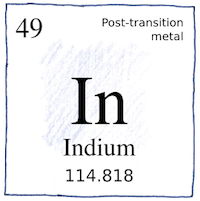Freiberg—Ferdinand Reich,
Hieronymous Theodor Richter
elements

|
Indium
It had become routine to examine minerals with a flame emission spectroscope. At the Freiberg University of Mining and Technology, Ferdinand Reich and Hieronymous Theodor Richter dissolved zinc ores and looked for the green lines of thallium but found an indigo line from an unknown element, which they named after its color in the spectroscope—from the Latin indicum, for the Indian dye.
Atomic number 49
Indium has a low melting point. Indium isn’t toxic. Indium isn’t nutritious. Indium tin oxide is in LCD screens. Indium is in superconductors. Indium can wet glass. Indium cries when bent.
Partners
Reich was color blind; he relied on Richter to read spectra. One man played the harp beautifully; another listened well. After his friend died, the harp player cut his strings and would not play again.



Isaac Newton identified indigo as the color between blue and violet, one of the seven colors in the spectrum and related to the seven notes of the major scale.
See also in The book of science:
Readings in wikipedia:
Other readings: